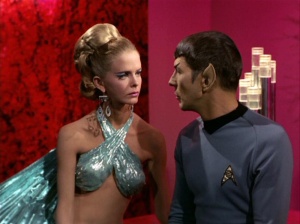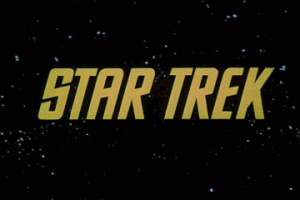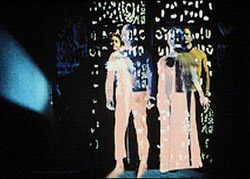>“The Cloud Minders”
 When I was about six or seven, Star Trek: The Motion Picture was hitting theaters. I remember this because it seemed like it was advertising a lot on the back cover of comic books my parents would buy for me and because there was a tie-in promotion with McDonald’s Happy Meals. (When I lived in Hawaii, the happening place for the under-10 set to have a birthday party was the McDonald’s with an outdoor playground). Those Happy Meals made the Motion Picture look a lot more action packed than it was and I recall begging my mom to take me to see the movie when it hit the base theater.
When I was about six or seven, Star Trek: The Motion Picture was hitting theaters. I remember this because it seemed like it was advertising a lot on the back cover of comic books my parents would buy for me and because there was a tie-in promotion with McDonald’s Happy Meals. (When I lived in Hawaii, the happening place for the under-10 set to have a birthday party was the McDonald’s with an outdoor playground). Those Happy Meals made the Motion Picture look a lot more action packed than it was and I recall begging my mom to take me to see the movie when it hit the base theater.
She agreed and I recall being…well, kind of bored. (I was six or seven at the time). But that didn’t discourage me from wanting to figure out what all this fuss about Star Trek was about. I recall watching an episode of the animated series one Saturday morning and thinking it was pretty good. Then, during a visit to my grandparents, I saw that repeats of the live-action series were showing and I begged my mom to let me stay up to watch it. I made it about half-way through (I can’t recall which episode it was) before an odd commercial came on and my mom announced that was enough Star Trek for one night.
I drifted away but came back to the series when Star Trek II was hitting theaters and a local independent station decided to show a couple of nights of Trek in primetime to celebrate. One of those was “Where No Man Has Gone Before,” which I watched with my dad and loved. I was so encouraged by how great “Where No Man” was, I decided I’d forego my usual cartoons the next day and catch a repeat of Trek in its 5 p.m. repeat slot.
That episode was “The Cloud Minders” and to my 10 year old mind, it was pretty darn good. Oh sure, it wasn’t as clever or entertaining as “Where No Man Has Gone Before,” but it still had a pretty good fight scene in the beginning and the whole city floating in the clouds thing was pretty cool as well. And yet, I still wasn’t quite hooked enough to jump in and watch every night.
And it seemed like for a couple of weeks, that every time I’d tune in, “The Cloud Minders” was repeating. I think my memory is cheating a bit here or it could be that I was seeing a lot of episodes where the crew beams down to a sound stage rock planet like we get here. But I have to admit it was pretty discouraging–especially since the commercials showed a cool clip where Kirk and Spock were reciting about being “Tweedle Dee” and “Tweedle Dum.”
As I saw more Trek, I came to realize that my initial assessment of “The Cloud Minders” as being pretty good wasn’t exactly spot-on. I think that, coupled with the notion that it was being re-run too much turned me against it early on and for a long time I listed it as my least favorite episode of the series. Then I saw “Way to Eden” and it came up second on the list.
So as I enter the home stretch for the final season of classic Trek, I have to admit I wasn’t looking forward to the watching “The Cloud Minders” again. I’d watched it about a decade ago but haven’t bothered with it on DVD. My reaction then was that it seemed a bit odd to have Spock beaming down and falling in love with the “lovely Droxine” but beyond that it didn’t really make much of an impression. This time around, I decided I’d approach it with a more open mind.
And I still come away kind of shrugging my shoulders. I’d no longer say I hate the episode, but there’s nothing here I especially love.
An agricultural colony is in desperate need of a mineral called zenite to cure a biological plague. The only source is the planet Merak II, a planet that we find out has a distinct social caste system. There are “haves” who live in Stratos, a city in the clouds and are the elite and then the “have nots” the Troglytes, who work in the mines and have none of the rights or amenities of the Stratos dwellers.
T he Enterprise is sent to get a supply and ferry to to the colony before all plant life on the planet dies. Kirk and Spock beam down to find the consignment not in the designated place. A group of rebel Trogyltes try to take the landing party hostage as a bargaining chip for greater rights. Kirk and Spock escape and the leader of the ruling council Plasus tells them they are welcome to wait in Stratos while his guards look for the consignment. They beam up there where Spock meets the “lovely Droxine.” Droxine is smitten when Spock and our usually stoic first officer is pulling out bad pick-up lines like “I’ve never met a work of art before.”
he Enterprise is sent to get a supply and ferry to to the colony before all plant life on the planet dies. Kirk and Spock beam down to find the consignment not in the designated place. A group of rebel Trogyltes try to take the landing party hostage as a bargaining chip for greater rights. Kirk and Spock escape and the leader of the ruling council Plasus tells them they are welcome to wait in Stratos while his guards look for the consignment. They beam up there where Spock meets the “lovely Droxine.” Droxine is smitten when Spock and our usually stoic first officer is pulling out bad pick-up lines like “I’ve never met a work of art before.”
Before you know it, Spock is flirting with Droxine in a way that’s sure to make Nurse Chapel cry herself to sleep at night and, possibly, discussing the Vulcan mating cycle. You remember that don’t you? The mating cycle that was so private Spock and Kirk were willing to risk their careers rather than talk about it?
 Anyway, before you know it Kirk is drawn into the planet’s conflict thanks to an attractive female rebel leader, Vanna. Vanna was trained in Stratos and knows their ways. She is captured and Kirk objects when she is tortured to get information about the rebels and the zenite. Kirk and Spock are ordered off the planet and Plasus threatens to call Starfleet and accuse Kirk of interference.
Anyway, before you know it Kirk is drawn into the planet’s conflict thanks to an attractive female rebel leader, Vanna. Vanna was trained in Stratos and knows their ways. She is captured and Kirk objects when she is tortured to get information about the rebels and the zenite. Kirk and Spock are ordered off the planet and Plasus threatens to call Starfleet and accuse Kirk of interference.
McCoy works out that raw zenite emits a gas that actually impairs the mental faculties of people. The Trogyltes can be cured if they wear filter masks. Kirk offers them to Plasus who vehemently denies the gas and thinks Kirk is trying to interfere. At this point, time is running out and Kirk takes matters into his own hands, beaming into Vanna’s cell, letting her know of the development and helping her escape. She promises to cooperate but is only going along to have a better hostage in Kirk.
Kirk eventually seals himself and Vanna in a mine and has Plasus beamed over to them. Kirk forces Plasus to mine to show him the effects of the gas are real. The two duke it out and Vanna realizes Kirk is telling the truth. She calls up to the ship and has Spock beam them on-board. She then agrees to give the Federation the zenite and it appears thing may be headed toward some type of new social order of the planet.
Reading the original David Gerrold outline for this story, I wish that story had been made. It offered a less cheerful ending and one that didn’t allow for a magical cure for the miner’s problems. Also, for a society this ingrained with such class inequity, it seems strange that the few representatives we see go from accepting the first status quo to accepting that change must occur. This is especially true of Droxine, who goes from an elitist snob to saying she’s headed down to the mines to dig some zenite herself. Of course, this could be to impress Spock and she’ll change her tune the minute he leaves.
At least the message behind the story isn’t as simplistic as “Let That Be Your Last Battlefield” and the script tries to delve into the history and development of the prejudice on display here. It’s also interesting to see Plasus threaten to call up Starfleet and “tell on” Kirk here. But it also brings up an interesting question of just how this social situation slipped past the Starfleet evaluation team. Was this overlooked because the planet is the only source of zenite? If this were a modern Trek, it’s easy to imagine Picard looking into the Federation’s motivations as well and to see what this might reveal.
And while Kirk does offer to come back and mediate between the two sides, I get the impression that this doesn’t happen. Hopefully he called Starfleet up to send out a skilled negotiator for when both sides do sit down to talk. Just accepting the facts behind the prejudice doesn’t suddenly mean both sides will see eye to eye around the negotiating table. It’s one of those cases where the budget cuts only allow us to see one representative from each side of the conflict and I have to wonder how many other Stratos dwellers and miners are going to be so quick to go along with the changes that Plasus and Vanna have undertaken at episode’s end.
It almost calls for a follow-up novel in the Pocket Books line of novels. Notice how I say almost here.
Again, it’s not terrible Trek, but it’s not great Trek either. There are some ideas in here, but they’re not as developed as they could be.
 When news broke yesterday that Star Trek was returning to our television screens, I was positively giddy. It’s been over a decade since we had new Star Trek on our television screens and I was delighted to see it would be back.
When news broke yesterday that Star Trek was returning to our television screens, I was positively giddy. It’s been over a decade since we had new Star Trek on our television screens and I was delighted to see it would be back.









